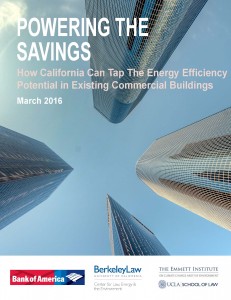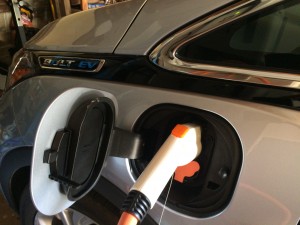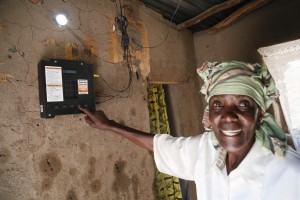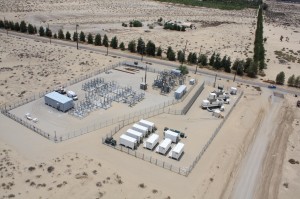If there’s one area where Trump is likely to have legislative success, it’s probably the budget and taxes. A partisan majority of Republicans in Congress will go along with any tax and spending cuts, leaving Trump in a good position to get his way. And his current budget proposal is nothing less than a full-scale assault on environmental protections and public health.
It’s a bad combination of Trump’s seemingly genuine antipathy to government regulations and his party being captured by big polluters in the oil and gas industry.
My UC Berkeley Law colleague Dan Farber runs through the numbers on Legal Planet, but they basically include massive cuts to environmental enforcement, restoration and monitoring, including on climate data, as well as eliminating research in clean energy.
The last part on clean energy cuts is particularly frustrating. I’ve blogged before about the success of ARPA-E, the most important governmental agency you’ve never heard of. It’s the “moonshot” agency that is funding breakthrough technologies in batteries, solar power and other vital technology. Since 2009, it has provided $1.3 billion in funding to more than 475 projects, of which 45 have then raised $1.25 billion in private sector funds.
So of course Trump and his allies want to eliminate the agency completely.
But all is not yet lost. The budget will go through a lot of sausage-making in Congress, and even many Republicans are invested in some of these programs, given the benefits they provide their districts.
But environmental and public health advocates will be starting from a tough position, and this is one area where Trump is likely to get a lot of what he wants.
Food may be the final frontier in environmental sustainability — specifically meat from animals. Meat production entails a huge environmental cost (let alone the morality concerns). Raising animals for slaughter involves significant agricultural production to produce the feed, which also causes pollution from fertilizers and energy inputs. And livestock like cows produces a lot of methane, which is a super-potent greenhouse gas.
That’s why a number of startups are looking at ways to produce meat from cells and other biological inputs, rather than from the animals themselves. Basically that means mimicking the natural process of producing meat from feed but not in an animal body.
I know it may sound weird, but if the food tastes good and isn’t bad for you, it would be a huge environmental — and economic — win.
And that’s because people are eating a lot meat, especially poultry, as the Wall Street Journal details:
U.S. consumers ate an average of 90.9 pounds of chicken apiece in 2016, according to the U.S. Department of Agriculture. That is nearly as much as beef and pork combined.
World-wide, about 61 billion chickens are raised for meat annually. The U.N. Food and Agriculture Organization has projected that chicken—relatively cheap to produce and with few religious and cultural barriers—will soar past pork as the world’s most-consumed meat by 2020.
Duck is relevant for a different reason. China, which tops the list in global consumption, consumes 2.7 million metric tons of duck meat annually, nearly 10 times the next-largest consumer, France, according to data from the International Poultry Council. The average Chinese consumer eats 4.5 pounds a year.
Now a new startup in the Bay Area appears to have developed a decent lab-produced chicken strip:
On Tuesday, Memphis Meats invited a handful of taste-testers to a San Francisco kitchen and cooked and served their chicken strip, along with a piece of duck prepared à l’orange style.
Some who sampled the strip—breaded, deep fried and spongier than a whole chicken breast—said it nearly nailed the flavor of the traditional variety. Their verdict: They would eat it again.
And not just environmentalists are taking notice. Cutting out the animal part of the equation could allow big meat companies to save a huge amount of money.
If entrepreneurs and scientists can figure this out, they will have done the planet (and many animals) a huge service.
To make any lasting progress on climate change, we’re going to need to be a whole lot more efficient with the energy we produce. That means retrofitting existing inefficient buildings as much as possible to reduce waste.
 The dream would be to make a home or commercial building energy retrofit as easy and scalable as rooftop solar has become. But so far nobody seems to have figured out how to do it. There are some promising options, which we explored in a recent policy report called Powering the Savings.
The dream would be to make a home or commercial building energy retrofit as easy and scalable as rooftop solar has become. But so far nobody seems to have figured out how to do it. There are some promising options, which we explored in a recent policy report called Powering the Savings.
But maybe the missing ingredient has been the insurance market. The idea is that if insurers are willing to back a home or business retrofit project, then financiers should be much more willing to bring Wall Street-type money to the effort on a mass scale. As PR Newswire reported:
Sealed, an energy software company that empowers homeowners to pay for home upgrades like insulation, air sealing, and smart thermostats with their energy savings, announced today the implementation of a residential energy efficiency insurance policy from The Hartford Steam Boiler Inspection and Insurance Company (HSB), part of Munich Re.
This innovative program insures the performance of Sealed’s proprietary energy analytics, which both removes energy savings performance risk from homes that finance energy efficiency improvements and increases the confidence of third party capital providers.
The key here is trusted and verifiable software that can measure actual energy saved via specific efficiency measures. With software improving to do just that, these kinds of financing arrangements will be just around the corner.
Want to know which counties in the U.S. accept climate science at the highest rates and which don’t? Which ones believe climate change is happening or that we should regulate carbon as a pollutant?
If that’s the case, then Yale has the interactive map for you. The school’s Program on Climate Change Communication just released its “Yale Climate Opinion Maps – U.S. 2016,” which breaks public opinion surveys down to the county level across the U.S.
It’s an easy-to-use map. While it doesn’t contain a huge amount of surprises (New England and the West Coast, particularly California, are pro-science accepters), it does reveal that climate science acceptance is actually fairly prevalent in red states. Standouts include southern and northern Arizona and much of South Texas. Montana, Idaho and South Dakota also have pretty striking pockets of science acceptance, as well as parts of Mississippi along the river to the northwest.
But there’s otherwise hard-core climate denial going on from the heart of Texas north through Nebraska, and throughout coal-country Appalachia (Kentucky and West Virginia).
The website is definitely an interesting way to spend a few minutes clicking around. Congratulations to Yale for putting it together.
 Could California’s entire set of vehicle emission standards, including its zero-emission vehicle program that has helped launch the global electric vehicle market, come under federal assault? It’s a worst-case scenario that would require congressional action, but it’s amazingly within the realm of possibility.
Could California’s entire set of vehicle emission standards, including its zero-emission vehicle program that has helped launch the global electric vehicle market, come under federal assault? It’s a worst-case scenario that would require congressional action, but it’s amazingly within the realm of possibility.
California has unique authority under the federal Clean Air Act to regulate vehicle emissions. That authority requires the state to first seek a “waiver” from less-stringent federal standards from the U.S. Environmental Protection Agency. The EPA always granted those waiver requests until the George W. Bush administration came along. His administration refused to grant a waiver for the state to regulate greenhouse gas emissions from tailpipes.
California sued, but the Obama Administration took office before the case was resolved and then granted the waiver. But now new EPA administrator Scott Pruitt is looking not only to refuse to grant future waivers but possibly roll back previously granted ones (Buzzfeed covered the issue on Tuesday with some quotes from yours truly). It would be an unprecedented step that would be sure to be challenged in court.
But the even deeper concern is that the litigation might prompt Congress to revoke California’s waiver authority altogether. The Atlantic has a great piece on the situation, including this passage quoting Debbie Sivas at Stanford:
She feared that this fight in the courts would accompany a political fight in Congress, as the administration would seek to amend the Clean Air Act to remove California’s waiver power before they lost the lawsuit.
And—almost in preparation for that battle—she asked Americans to take a step back and examine why regulating greenhouse gases from cars is important.
“It feels like this very technical thing about, ‘blah blah, waivers, blah blah blah,’ but it’s a very important part of the climate policy,” Sivas told me. “People aren’t going to stop driving, really. And transportation’s 40 percent of carbon emissions. The only way to get [those emissions] down is to get [fuel] mileage up. If the feds are going to take their foot off the gas—and to fight the states who are doing it—it could be a huge setback,” said Sivas.
There’s a lot at stake in this fight. Federal fuel economy standards are prompted by California’s authority on the issue, and future standards could definitely be at risk. I have a lot of confidence in California’s legal team to fight this assault, but it would be a major setback for the time being.
But if Congress were to revoke the waiver status, and even retroactively apply it, the future of both cleaner gas-powered cars and the nascent electric vehicle market would be at tremendous risk.

Elizabeth Mukwimba is a 62-year-old Tanzanian woman who now has solar lighting and electricity in her home at the flick of a switch, thanks to an off-grid project. Photo from Off-Grid Electric.
Tanzania exemplifies so much of the future of energy infrastructure in developing world countries, as Greenbiz describes:
The East African country of Tanzania faces a serious electrification challenge. Only 2 percent (PDF) of rural households have access to electricity, and most of the rural population relies on expensive, hazardous and low-quality fuels such as kerosene for lighting and charcoal for cooking.
Access to electricity and other modern energy services is fundamental to human well-being and to a country’s social and economic development. In many countries, electrification through off-grid applications has become a cost-effective alternative to conventional grid expansion in remote areas — and this could become a model that propels Tanzania’s next phase of economic growth. Already in the country, energy systems based on wind, small hydropower, biomass and solar resources are being used successfully to meet energy demand in isolated villages. By integrating these renewable-powered off-grid systems, rural communities are increasing their access to affordable energy supplies while contributing meaningfully to climate change mitigation.
Much like the leap to cell phones over landlines, many countries like Tanzania are better served going directly to decentralized, renewable technologies rather than building expensive and dirty traditional power grids with central-station power plants and far-flung transmission lines.
The upside is a cleaner, more resilient energy system with potentially few impacts on the land. It also means more immediate electrification for rural residents, rather than making them wait for government and utilities to build a centralized grid to reach them.
I note that in this article, batteries do not seem to be on the table for Tanzania’s rural areas, while biomass may make up a crucial portion of the electricity mix. I have nothing against biomass in concept, but depending on the technologies and incentives involved, it can sometimes lead to increases in emissions.
These opportunities in many ways come from the developed world’s investment in renewable technologies, which has brought prices down to the point where they are now viable options for poorer countries like Tanzania.
This year has been a doozy for climate change. February is on pace to break all sorts of records for the warmest ever recorded. Washington DC, for example, has temperatures similar to Honolulu the past few days. And it’s not just a blip: each year that passes has broken records from the previous year for hottest year on record.
Here in California we’re now experiencing what scientists have warned about: extreme drought followed by extreme rain. We just finished a record drought and are now on pace for record rainfall this year.
These extremes are badly stressing our infrastructure, from dams like Oroville to shuttered highway around the state. To discuss the state of infrastructure in an age of climate change, I participated today on a press briefing via Climate Nexus.
I was joined on the panel by:
- Noah Diffenbaugh, Senior Fellow at the Stanford Woods Inst. for the Environment, expert on climate change & impacts in CA.
- Juliet Christian-Smith, Senior Climate Scientist at the Union of Concerned Scientists, expert on water infrastructure.
We received questions at the end from members of the press, but the discussion could be of interest to anyone. Here is the audio:
Audio PlayerAs the price of solar panels and batteries decreases, our electricity system is starting to look a lot cleaner and more decentralized. While some people think the rise of community-based electricity technologies will undermine utilities, utilities are in fact embracing one version of decentralized power: microgrids.
Utilities are finding microgrids to be a great resilience strategy for avoiding outages, particularly in rural areas or crucial population or job centers. Greentech Media reports on the trend:
San Diego Gas & Electric delivers power to the town of Borrego Springs via a single radial transmission line running through the desert. Lightning strikes and desert flash floods threaten that line, resulting in historically poor reliability, Chief Engineer Thomas Bialek explained at the DistribuTech panel.
The utility needed to maintain or improve reliability for the nearly 2,800 Borrego Springs customers, but the traditional fix — building out a parallel transmission line — was pricey. A microgrid would be three or four times cheaper, Bialek said. So that’s what they did.The system, paid for by SDG&E, the Department of Energy and other partners, combines diesel generators, large and small batteries, and rooftop solar PV.
The microgrid has already proven itself in the face of adversity. When a flash flood in September 2013 downed transmission poles and lines leading to the town, the microgrid fired up and restored power to 1,056 customers while the grid repairs unfolded. That covered the core city center, so that those residents who didn’t have power yet could move to central facilities for shelter from the heat.
The future portends even more investment in microgrids, as Utility Dive notes:
Last year, GTM Research estimated there were 156 operational microgrids in the country, making up 1.54 GW of capacity, and that number is expected to rise to 3.71 GW by 2020. Globally, Transparency Market Research believes the microgrid market will be worth about $35 billion by 2020 — up from $10 billion in 2013.
But as microgrids — and the technologies that underpin them — become cheaper, utilities may be sowing the seeds of their own destruction. With a few additional breakthroughs, these technologies could eventually allow entire communities to defect from the grid, leaving utilities and their remaining ratepayers stuck with stranded assets.
But for now, these installations will provide an environmental and energy win, while furthering investment in the technologies needed to clean and decentralize the electricity sector.
No clean technology is more important than the battery (or energy storage more broadly, given that batteries are just one — albeit critical — version of storage). Batteries will soon help power almost all of our vehicles with cleaner electricity instead of fossil fuels. And they’ll help store our surplus renewable power to clean our electricity grids.
The PBS show NOVA just ran a fascinating episode on the subject, called The Search for the Super Battery. It features interviews with UC Berkeley colleagues Dan Kammen and Venkat Srinivasan, as well as car company representatives and other industry leaders. As far as shows on batteries go, this one is pretty fascinating and accessible and well worth the watch:
Happy Friday viewing!

 Donald Trump and his Republican backers have long railed against environmental laws and regulations that disfavor coal. Trump won in part by promising to bring back coal mining jobs.
Donald Trump and his Republican backers have long railed against environmental laws and regulations that disfavor coal. Trump won in part by promising to bring back coal mining jobs.


